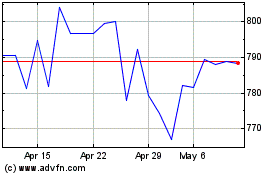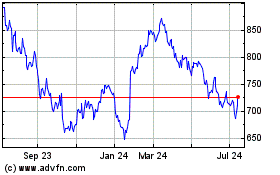Sales of Luxury Alcohol on the Rise Again in China
October 16 2015 - 10:49AM
Dow Jones News
By Jason Chow in Paris and Laurie Burkitt in Beijing
After nearly three years nursing a hangover, China is hitting
the bottle again.
Sales of expensive alcohol took a massive hit in China in 2012,
when President Xi Jinping took aim at boozy banquets and lavish
gift-giving. Now, cognac and wine sales are showing signs of life,
indicating that luxury consumption may be on the way back.
Shipments of the French brandy to China jumped 42% in the first
nine months of the year, according to industry association BNIC,
boosting the fortunes of industry stalwarts such as French luxury
giant LVMH Moët Hennessy Louis Vuitton and Rémy Cointreau SA.
The resurgence reveals a pocket of strength among Chinese luxury
consumers, who in recent years have determined the fortunes of
manufacturers of everything from expensive handbags, to
diamond-encrusted watches and pricey bottles of alcohol. LVMH and
Burberry Group reported earlier this week continued sluggish demand
among Chinese buyers for fashion and accessories due to slowing
growth and the summer's stock market crash. But others point out
that a rising young consumer class is emerging which has already
begun to drive future luxury spending.
"There is a significant change in who's consuming cognac today,"
said Trevor Stirling, a drinks analyst at Sanford C. Bernstein in
London, pointing out that businessmen and bureaucrats who used to
shell out $150 per bottle at hostess bars on expense accounts are
no longer the main drinkers, victims of the government crackdown on
corruption.
Taking their place are young, upper-middle-class drinkers who
are spending their own money and opting for lower-priced bottles.
While the young drinkers aren't splurging like their predecessors,
they represent a much larger group of consumers.
Some are already chasing this demographic: French drinks
conglomerate Pernod Ricard SA last year launched its Martell
Noblige line, a cognac with a lower price tag than other Martell
products that is less offensive in today's Chinese political
climate.
"When does the growth of new consumers more than compensate for
the loss of the old ones? We're not there yet, but we're getting
close," said Mr. Stirling.
Cognac was a popular status symbol during China's most recent
boom, a favorite drink served to impress at banquets and a frequent
gift bought at duty free shops to be exchanged between businessmen
and top bureaucrats.
The drink fell out of favor as the anticorruption campaign took
bite and liquor distributors and retailers in China were stuck with
large stockpiles of unsold bottles. Mr. Xi, in his message
promoting thriftiness was clear: He specifically told officials not
to serve drinks with the simple dinners he espoused. That inventory
slack has now been sold off, and cognac makers are resuming
shipments, showing that the downturn appears to have bottomed
out.
Drinks makers are cautiously optimistic. "Mainland China is
seeing some real improvement, said Rémy Cointreau Chief Financial
Officer Luca Marotta. The company, which makes Remy Martin cognac,
said Friday that its volume growth in China in the third-quarter
was flat, and the preference was for lower-priced bottles. Chinese
liquor wholesalers remained cautious given the uncertain economic
outlook, he said.
Earlier in the week, strong cognac sales were the surprise
bright spot for LVMH, with 12% more cognac shipped in the third
quarter of this year than in the same period a year earlier. Part
of the increase was due to stocking-up in anticipation of the busy
Golden Week shopping season--a week-long holiday period in early
October.
LVMH Chief Financial Officer Jean-Jacques Guiony said there was
"a clear sign that the market is bottoming out."
China's wine consumption is expected to jump 10% this year, up
from 1.58 billion liters in 2014, according to the EU SME Centre, a
research consultancy of the European Union.
Consultants say that younger consumers are picking up the slack
in alcohol sales. Much of the interest in wine is driven by the
younger generation born under China's one-child policy, who are now
entering their 30s, who aren't going for the top-flight grand cru
Bordeaux bottles, but for more modestly-priced bottles. Those born
since 1980 are expected to contribute to 35% of the country's total
consumption by 2020, up from 15% now, according to financial
services company Credit Suisse.
Write to Jason Chow at jason.chow@wsj.com and Laurie Burkitt at
laurie.burkitt@wsj.com
Subscribe to WSJ: http://online.wsj.com?mod=djnwires
(END) Dow Jones Newswires
October 16, 2015 10:34 ET (14:34 GMT)
Copyright (c) 2015 Dow Jones & Company, Inc.
Lvmh Moet Hennessy Louis... (EU:MC)
Historical Stock Chart
From Mar 2024 to Apr 2024

Lvmh Moet Hennessy Louis... (EU:MC)
Historical Stock Chart
From Apr 2023 to Apr 2024
